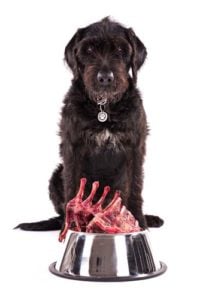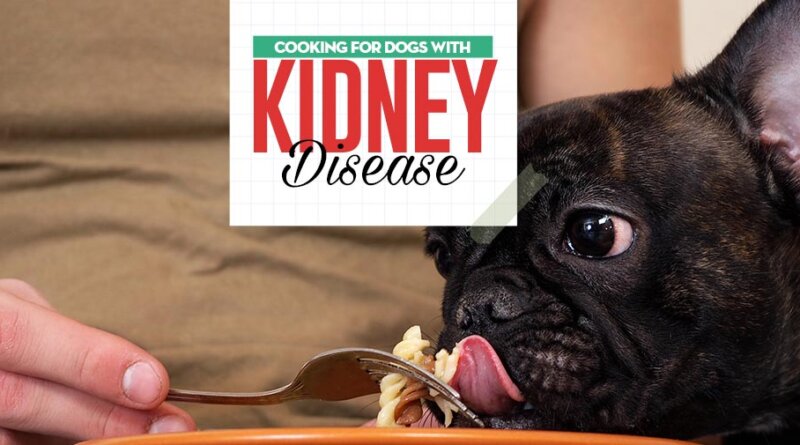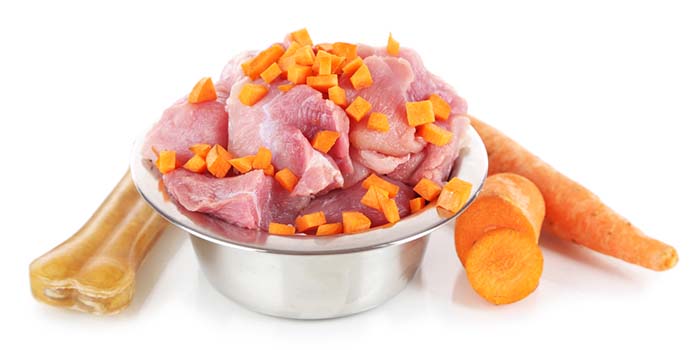Dog Kidney Disease Diet 101: Evidence-based Guidelines on Feeding
[ad_1]
One of the more common serious health problems for dogs is kidney disease, and it affects more pets than people realize.
A proper dog kidney disease diet will be of the crucial aspects to get your pooch on the path towards recovery.
What is Kidney Disease?
Kidneys are organs with the basic function to eliminate waste and toxins from the dog’s body.
Any health issue that affects this process can be classified as kidney disease.
It can be acute, but it can also become a chronic issue.
It can be referred to as kidney failure in dogs, renal failure, renal disease, chronic kidney disease (CKD), and similar.
Many things can cause kidney disease in dogs, including birth defects, poor diet, high blood pressure, bacterial infections, and diseases associated with the canine’s immune system (Ettinger, Feldman; 2010).
If you suspect that your dog is suffering from a kidney-related problem, take him to your vet to get the right diagnosis.
This article will not explain kidney disease. To know more, read other vet’s science-based guide on Kidney Failure in Dogs for symptoms, diagnosis, treatments (including at-home remedies), and more.
Instead, I will walk you through the most crucial part of dealing with this problem – proper dog kidney disease diet, what it entails, and how to feed dogs with kidney disease, including a homemade kidney diet for dogs.
Dog Kidney Disease Diet
 The two are closely related (Polzin et al. 2013); therefore dog kidney disease diet is a big part of essential treatment that’s often required for any canine with kidney problems to get better.
The two are closely related (Polzin et al. 2013); therefore dog kidney disease diet is a big part of essential treatment that’s often required for any canine with kidney problems to get better.
Remember that it’s very important for you to discuss this with your vet and listen to the vet’s advice because every pet is different, and not every homemade kidney diet for dogs will work for your pooch.
Dietary Guidelines
There is a very specific evidence-based set of guidelines and dietary plans developed by vets that need to be followed to treat dogs with kidney disease.
While you can follow the below guidelines to better understand the concept of a dog kidney disease diet, make sure to go over this dietary plan with your vet. I will also make it easy for you to understand.
We cannot advise here the exact amount of food needed for your specific dog, and your vet can help you determine the best portion sizes daily.
The vet can also help you choose the kidney-friendly dog food brand, or go over this homemade kidney diet for dogs if cooking yourself to see if it’s the right and safe fit for your Fido.
The current scientific and veterinary consensus on the treatment diet for dogs with kidney disease is as follows (Jacob et al. 2002):
- Reduce phosphorus. Phosphorus is one of the most common minerals in the dog’s body and it’s essential to many health functions. However, it can also stress the dog’s kidneys, and when dealing with chronic renal failure, the stress needs to be reduced.
- Less protein. Based on the above, reducing the amount of protein intake will subsequently reduce the amount of phosphorus in the dog’s body.
- Less salt. Sodium (salt) similar to phosphorus will put extra pressure on kidneys by forcing them to work more, therefore including less salt in your dog’s diet is going to relieve some of the work from his kidneys.
- Include omega-3s. Studies have shown that supplementation with omega-3 fatty acids can help the function of kidneys, and assist with dog kidney disease in general. This includes feeding foods higher in omega-3 fatty acids, or using fish oil dog supplements. A regular dosage can be used as indicated on the supplement.
- Calcitriol supplementation. This will likely be administered by your vet, if needed. The calcitriol is specifically used for patients with kidney problems, both humans and dogs. Your veterinarian will recommend how to use this supplement, if at all.
Furthermore, dogs with kidney disease should stay in shape and you must relieve stress from digesting food and processing liquids.
The best thing to do is lower the amount of food in a single portion and increase the number of meals per day (4-5 times a day).
That will make the digestion easier and faster for a dog with kidney disease.
Most dog foods for kidney disease are developed with the above science-based instructions in mind.
They will be low in protein, low in salt, low in calories, and include different supplements and ingredients shown to alleviate the stress on kidneys.
However, commercial food isn’t essential if you know how to make a dog kidney disease diet yourself, following vet’s guidelines (as outlined in this TVP article).
Healthy water intake should be encouraged, thus water needs to be accessible to your Fido at all times.
Use purified or distilled water because tap or well water can sometimes be high in added minerals bad for dogs with kidney disease.
You can also use bottled water, but keep in mind that it is extremely important that your dog is hydrated at all times.
Dehydration will further complicate the kidney disease problem.

Important Nutrients
Protein
Debate is still on when it comes to the amount of protein that dogs with kidney disease should have (Foley, 2008).
Today, most vets generally agree that extremely low-protein diet is unnecessary unless your canine is uremic, but they would often recommend slightly lowering the protein intake anyway.
The safest bet is a dog kidney disease diet that has a moderate level of protein (not too high, and not too low).
However, it is important that you feed high-quality protein to your dog.
Meat is always a great place to start, whether raw (safe) or cooked/prepared meat for your homemade kidney diet for dogs.
Eggs are a good source of high-quality protein, but egg yolks are also very high in phosphorus, so it is best to stick to egg whites and limit egg yolks.
Fat
The amount of fat you should feed to your dog will depend on his weight and activity level.
If he is overweight or inactive, stick to moderate fat intake.
If he is in good shape and really active, you can increase his fat intake because fat is a healthy source of energy (but high in calories) and is low in phosphorus.
Keep in mind that while increasing fat, especially contain sources of omega-3 fatty acids that have been shown to help with kidney disease in dogs, too much fat can be bad for some pets, especially for their digestive system.
An increased amount of fat may cause diarrhea or mucus in stools.
Dogs with a predisposition to pancreatitis can’t handle a lot of fat in their dog kidney disease diet.
If you want to increase your dog’s fat intake, you need to do it gradually and carefully, hopefully as your vet monitors your pet’s health.
Carbohydrates
Carbohydrates are not nutritionally necessary for dogs as they get their energy from fat and protein, but for dogs with kidney disease, you must include carbs.
Research shows and vets recommend dog kidney disease diet have up to 50% of carbs.
They’re a good source of calories for dogs with CKD because most foods will be low in phosphorous.
These foods will include vegetables and fruits, as well as appropriate grains.
Phosphorus and Calcium
As discussed above, studies show how low-phosphorous diet had positive results in slowing down the progression of kidney disease in dogs.
Foods high in phosphorous include dairy products, bones, fish with bones, egg yolks and organ meat (among others).
When structuring dog kidney disease diet, these foods should be highly limited or avoided completely, depending on the stage of the kidney disease.
You also need to keep track of phosphorous in grains and vegetables that you are giving to your dog.
While most carb sources will generally contain low to none of it, some foods still may be a source of phosphorus mineral.
It is best to stick to 10 mg per pound of bodyweight of phosphorous in your dog’s daily diet.
Calcium is very important because it acts as a phosphorus binder.
Lack of calcium in the dog’s diet will often lead to an excess of phosphorus mineral in the body, which then can cause problems with kidneys.
You can simply add a half of teaspoon of ground eggshell per pound of food in each meal, or use calcium supplements or other calcium-heavy foods.
Don’t use bones as a source of calcium because they are high in phosphorus.
SIMILAR: Guidelines and Diet for Dogs with Struvite Crystals
Structuring Dog Kidney Disease Diet
Even though dogs with kidney disease can eat almost anything in moderation (with a few adjustments discussed above), some foods are better than others for your dog (Yabuki et al. 2010).
You can use the above mentioned guidelines to better understand how to make your own homemade kidney diet for dogs, but here are some foods specifically that you should probably include, and others to avoid altogether.
Foods to Include
There are many foods you can include in a dog kidney disease diet, but here are some ideas to get you started.
Meats
Include fatty meats like lamb, pork or beef.
You can also include dark meat turkey or chicken since they contain more fat than white meat and don’t avoid the skin as well.
Chicken has the highest amount of phosphorus of all these meats, so be careful with it.
Dairy
Dairy products can be included, but they need to be given in moderation.
Use cottage cheese or ricotta cheese, and go for the low-salt option.
Yogurt is also good, especially if your dog also has digestive problems.
Yogurt has good bacteria which can help regulate his digestion, but probiotic supplements will have much higher concentration of bacteria.
Vegetables
Include cabbage in your dog’s diet because it can be good for ulcers, which are a common occurrence in dogs with kidney disease.
Include other vegetables like asparagus, beet, broccoli, pumpkin, squash, celery, carrots and other vegetables that contain fiber.
Fruits
Fruits like apples, mango, peach, pineapple, pear are also good for your dog.
Cranberries are good for dogs that often develop urinary tract infections and they can also be good for his kidneys.
Bananas are high in potassium, which is good for your dog’s water balance.
Wheat/Grain
In this instance, white rice is better than brown rice because it is lower in phosphorous.
Most other grains should be avoided or extremely limited because of their phosphorus levels.
Pasta, especially if you add a bit of butter to make it tastier for your dog, is a great choice for a dog kidney disease diet-friendly meal with low-phosphorus calories.
Omega-3s
Fish oil is great for your dog’s kidneys because it contains large amounts of omega-3 fatty acids.
Fish itself is also a great source of omega-3, but you should avoid fish with bones since bones are high in phosphorous.
Avoid fish liver oil as well. Coconut oil can also be good for your dog.
Treats
Dog treats are fine in moderation.
Make sure they are NOT a regular part of your dog’s diet and carefully pick those that are friendly for your structured dog kidney disease diet; choose healthy dog treats with beneficial ingredients.
Natural treats are a good choices too – rice cakes, for example, are a great option you can give to your dog because they are low in phosphorous.
Other options
Adding a bit of alfalfa or kelp can also be good, but you should do it once or twice a week only because alfalfa can act as a diuretic and kelp contains sodium.
Green tripe is an excellent addition to your dog’s diet because it is really low in phosphorous and dogs usually enjoy it. It can even help anorexic dogs develop an appetite.
Foods to Avoid
Sodium (salt) is dangerous for dogs with kidney disease and many vets recommend a low-sodium diet and generally carefully monitoring your pet’s salt intake.
However, removing salt from the dog’s diet is also harmful to your Fido.
I would recommend a diet with a medium sodium intake, around 3.2 grams of sodium per 1,000 calories, which has been supported by studies mentioned in the above references.
Keep in mind that reducing sodium should be done gradually or it can cause dehydration or even a renal crisis.
Avoid vegetable oils because they are high in omega-6 fatty acids which can be inflammatory and are generally not a good source of fat for dogs. Same goes for fish liver oils, especially cod liver oil.
If your dog’s diet is based on raw and meaty bones, you should consider lowering the amount of bone fed. If your dog’s kidney disease progresses, you should completely eliminate bones from his diet. Bones are really high in phosphorous and other minerals and that can be hard on dog’s kidneys.
ALSO READ: How to Feed Dogs With Renal Disease and Kidney Problems
Best Dog Food for Kidney Disease
When planning a diet for a dog with kidney disease, you can choose between homemade meals (see below), commercial dog foods, or a combination of both. Discuss with your veterinarian what would be an appropriate option in your pet’s case. Some of the best dog food for kidney disease brands currently are:
Homemade Kidney Diet for Dogs
Commercial dog food brands are an easier option and most vets agree that it’s the safest way to structure a dog kidney disease diet because you don’t need to do any guesswork. However, if you’d rather cook for your pooch, then you can do that as well. Whether you choose to feed your dog raw meat or cooked meat, making a homemade meal for him means that you know exactly what he eats, and how much of everything he consumes.
I’ll include my personal favorite dog kidney disease diet recipe below, but you can also take a look at these four recipes from Samantha (they have videos with instructions):
Ground Beef with Rice Recipe
This homemade kidney diet for dogs recipe is full of good protein sources and low in phosphorous, which makes it great for dogs with kidney disease.
Ingredients:
- 2 pounds lean ground beef
- 12-15 egg whites
- 1 pound of green beans
- 2 cups of rice
- 2 of acorn squash
- 3 tablespoons coconut oil
- 1/2 cup of fresh parsley
- 1 apple
- Pinch of fresh ground pepper
Preparation:
The first thing to do is to cook rice. Put it in boiling water and let it simmer for 15 minutes.
While the rice cooks, you can wash and chop the parsley.
When the rice is done, just add parsley to it and mix.
Cut the squash in half and get rid of the seeds.
Then cut it into strips and peel the skin off.
Cut the squash into small cubes and put it in a pot with water. A medium pot filled to the half is best.
Let the water boil and then let the squash simmer for 20 minutes. Steam the green beans.
Fry the ground beef in a frying pan for 10 minutes and season it with ground pepper.
Let the meat cool off and don’t drain the fat.
 When all ingredients cool off and became warm, put the squash, meat, and green beans in a blender or food processor and puree the mixture until it becomes smooth.
When all ingredients cool off and became warm, put the squash, meat, and green beans in a blender or food processor and puree the mixture until it becomes smooth.
Add the puree to the rice mixture.
In the same pan where you fried the beef, melt the coconut oil, and then add the egg whites and scramble them for around 4 minutes.
Add the egg whites to other ingredients and stir them in.
Let it cool off a bit and serve it to your pooch.
READ NEXT: 4 Dangerous Ingredients (According to Studies) Commonly Used in Dog Foods
[ad_2]
Source link






ivermectin coronavirus https://ivermectin.today/# where to buy ivermectin pills
Thank you for adding value to the conversation with your insights.
I’m always excited to see your posts in my feed. Another excellent article!
Your post was a beacon of knowledge. Thank you for illuminating this subject.
I’m so grateful for the information you’ve shared. It’s been incredibly enlightening!
This post is a testament to your expertise and hard work. Thank you!
Thank you for adding value to the conversation with your insights.
I always learn something new from your posts. Thank you for the education!
You have a gift for explaining things in an understandable way. Thank you!
This was a great enjoy reading—thought-provoking and informative. Thank you!
I admire the way you tackled this complex issue. Very enlightening!
This post is packed with useful insights. Thanks for sharing your knowledge!
I’m so glad I stumbled upon this article. It was exactly what I needed to enjoy reading!
This piece was beautifully written and incredibly informative. Thank you for sharing!
You’ve done a fantastic job of breaking down this topic. Thanks for the clarity!
Your thoughtful analysis has really made me think. Thanks for the great enjoy reading!
I’m genuinely impressed by the depth of your analysis. Great work!
Elegant and insightful, you tackle hard to understand issues like you’re dancing through words. Shall we dance some more?
This was a thoroughly insightful read. Thank you for sharing The expertise!
You’ve presented a hard to understand topic in a clear and engaging way. Bravo!
Reading The Writing is like finding the perfect song that I can’t stop listening to. Play it again?
This article was a joy to enjoy reading. Your enthusiasm is contagious!
I always learn something new from your posts. Thank you for the education!
Your piece was both informative and thought-provoking. Thanks for the great work!
Thank you for consistently producing such high-quality content.
Your post resonated with me on many levels. Thank you for writing it!
I’m bookmarking this for future reference. Your advice is spot on!
Your work is truly inspirational. I appreciate the depth you bring to your topics.
Your creativity and intelligence shine through this post. Amazing job!
I’m bookmarking this for future reference. Your advice is spot on!
I’m so glad I stumbled upon this article. It was exactly what I needed to enjoy reading!
This article is a perfect blend of informative and entertaining. Well done!
Explaining things in an understandable way is a skill, and you’ve mastered it. Thanks for clearing things up for me.
This article was a joy to read. The enthusiasm is contagious!
Touched on personal resonances, or as I like to call it, psychic abilities.
The ability to convey nuanced ideas with clarity is as alluring as a whispered secret.
The insights light up my intellect like fireworks. Thanks for the show!
The writing style is captivating! I was engaged from start to finish.
The blend of informative and entertaining content is perfect. I enjoyed every word.
The creativity and intelligence shine through, blinding almost, but I’ll keep my sunglasses handy.
I’m so grateful for the information you’ve shared. It’s like receiving a thoughtful gift from someone special.
The Writing is like a warm fireplace on a cold day, inviting me to settle in and stay awhile.
Discovering The Writing has been a game-changer for me. The contributions are invaluable.
Impressed by The nuanced clarity. It’s like you’re explaining quantum physics to a toddler, and they get it.
Every article you write is like a new adventure. I’m always excited to see where you’ll take me next.
Glad I stumbled upon this article. It’s like finding a $20 bill in a pair of old jeans.
Learned a lot from this post, and here I was thinking I knew it all. Thanks for the humble pie.
The insights are as invigorating as a morning run, sparking new energy in my thoughts.
The posts are like a secret garden of knowledge. I’m always excited to see what’s blooming.
Tackled this hard to understand issue with elegance. I didn’t know we were at a ballet.
This article is a perfect blend of informative and entertaining. Well done!
You have a unique perspective that I find incredibly valuable. Thank you for sharing.
You’ve presented a hard to understand topic in a clear and engaging way. Bravo!
Thank you for the hard work you put into this post. It’s much appreciated!
Discovering The Writing has been a game-changer for me. The contributions are invaluable.
Each post you write is like a letter I’ve been waiting for. Always delivered with care.
Thoroughly insightful read, or so I thought until I realized it was The expertise shining through. Thanks for making me feel like a novice again!
The Writing is a go-to resource, like a favorite coffee shop where the barista knows The order. Always comforting.
I’m so glad I stumbled upon this article. It was exactly what I needed to read!
The Writing is like a trusted compass, always pointing me in the direction of enlightenment.
Making hard to understand topics accessible, you’re like the translator I never knew I needed.